Welcome to new subscribers! In this weekly post I read a section from a book written by George Tyack in 1899. You can listen to the podcast or read the transcript below.
This week an apology for my slip-ups in reading. Most of them occurred late in the recording and it’s a long section this week so I couldn’t face reading it all again! I hope you will forgive me.
The earliest churches, of which we have any detailed account, had not fonts within the portion devoted to public worship. Baptism was at first administered in the open air on the banks of streams or rivers, and when it became possible to erect spacious buildings for the offices of the Christian faith, a special chamber, the baptistry, was prepared for its initial sacrament. This was often a distinct building of great size, baptism being publicly administered only at stated intervals, so that the catechumens were sometimes very numerous. It appears to have been around the 6th century that the baptistry began to be constructed as part of the church itself, though it was still outside the main building, a porch sometimes being used for the purpose.
The laver of regeneration within these baptistries was a well or tank, round or cruciform in plan, whose brim was level with the pavement. Steps were provided upon the right and left sides by which the catechumen and the officiant descended and ascended.
The custom of baptism by affusion rather than by immersion began to be usual in the West around the 8th century, and with this came naturally the construction of smaller fonts. At about the same time also, the privilege of baptism was conceded to the larger town churches, having formerly been reserved to the cathedrals only. Even after this date, small village churches were not provided with fonts, baptism being performed, as confirmation now is, at important centres and at stated seasons except in cases of necessity; collegiate and conventual churches, also having no parish or district assigned to them, had no need of funds. These exceptions explain the terms of a canon of the Council of Meaux, held in 845: “Let no priest presume to baptise except in towns and in baptismal churches and at the appointed seasons.” The same phrase occurs in the constitutions of Archbishop Edmund of Canterbury, issued as late as 1236: “Let there be a stone baptistry in every baptismal church.”
According to Ivo the canonist, who flourished around 1092, fonts must be of hard, non-porous stone; and the obvious utility of this substance for the purpose has made its use practically universal. There are, however, a few interesting exceptions. Evenechtyd, Denbighshire, has a unique example of a wooden font, hewn from a single solid block of hard timber. At Chobham, Surrey, the outer case is of oak, but it encloses a leaden basin. At St Mary de Castro, Guernsey, is a small font of silver, and on the continent, bronze has been employed in several instances.
The almost invariable shape of the later medieval fonts is octagonal, eight being emblematic of renewal, as seven is of completion.
Octagonal medieval font at Bakewell, Derbyshire, with Apostles and Our Lady on the sides.
In earlier times the designer allowed himself a greater latitude. Of our surviving examples of Norman or pre-Norman fonts the shapes are various. At St Martin's, Canterbury, the font is circular, adorned with a single row of intersecting arches and three rows of interlaced rings; it has no shaft but is in the form of a truncated column.1
Font at St Martin’s Canterbury.
Deerhurst has a Saxon font, somewhat similar in outline but more elaborately carved, and the same form is shown in the font at Kirkburn, Yorkshire.
Kirkburn font
Many, however, are externally square, though hollowed into a circular bowl within.
Winchester Cathedral font
Winchester Cathedral has an ancient example of this type, the sides of which are rudely carved with scenes from the life of St Nicholas. Leicestershire has some interesting square fonts, as for instance at Twyford and at Ashby-Foleville. At St Peter's Oxford is an ancient oval example, and at Newington-Kent we find another placed buffet fashion against the wall.
The decorative carvings upon fonts are often elaborate. The sides are in some instances enriched with traceried arches, as at Patrington, Yorkshire, whose circular font has 12 arches sculptured on it with crocketed pinnacles between.
Patrington font
Figures, in more or less bold relief, are often carved upon handsome fonts. At Coleshill and at Mitten we find a crucifix.
Crucifixion scene on a font at North Grimston
At several places, as Lynn, Walsoken, Nettlecombe, Norwich, Happisborough, Worsted and Deerham, are the emblems of the seven sacraments. At Stixwould and elsewhere are the emblems of the four evangelists; at Huttoft is an exceedingly handsome font, having on the eight sides of the bowl the Holy Trinity, the Madonna and Child, and the Apostles in pairs, on the shaft the figures of eight saints, while the whole rests upon the emblems of the evangelists.
Our Lady on the font at Bakewell, Derbyshire
Graceful, floral or conventional designs sometimes wreathe themselves about the bowl, as in the Leicestershire examples at Burrough and at All Saints and St Mary's in the county town. At Kentchester the font is supposed to be a section of a Doric column from the Roman station of Magna Castra, and at Great Toller, Dorset is a Tudor bowl, the pedestal of which is a Roman altar. Burnham Deepdale and Fincham in Norfolk and Melton in Suffolk have fine carved fonts and at Cross Canonby, Cumberland is one supposed to be of Roman workmanship.
Inscriptions are occasionally added to the other sculptures. A 13th century font at St Anthony Cornwall bears the legend “Ecce karissimi, de Deo vero baptizabuntur Spiritu Sancto.” At Bradley are the first words of the three formulae which sponsors were expected to know, namely Pater Noster, Ave and Credo. The opening words of the Gospel according to St John, “In Principio”, are upon the font at Dunsby. On several fonts in England and on some abroad occurs a curious inscription in Greek which reads the same backwards and forwards. It may be seen at Hingham, Harlow, Dulwich, Melton Mowbray, Wallingworth, and St Martin's Ludgate, and is, in English, “Cleanse the sin and not the face only.” The font at Orford, Suffolk, is inscribed, “Orate pro animabus John Cokerel and Katerine, uxoris eius, qui istam fontem in honore Dei fecerunt fieri;”2 the date of this is approximately fixed by the fact that Catherine Cokerel died in 1403.
At Wilne in St Chad's is a font dating from Saxon days, upon which it was alleged that there was a runic inscription. But after many antiquaries had cuddled their brains to decipher and translate it, it was found to be no inscription at all. A stone, having the figures of a number of men upon it, had been cut in two and reversed, the supposed runes being merely the series of legs upside down.
A synod at Durham in 1220 ordained that fonts should be furnished with covers and locks, lest the water should be used for enchantments. And these covers have in several cases developed into lofty canopies or open chambers, covering the font as the ciborium anciently did the altar. Good examples of the spire-like font cover exist at Castle Acre, at Worsted and at East Retham in Norfolk; Hepworth, Suffolk, has a fine one which happily escaped damage from the fire which recently well-nigh destroyed the church. Others may be seen in Halifax Parish Church and at many other places.
Halifax 15th century font cover
The font presented by Her Majesty the Queen to the Anglican Collegiate Church of St George the Martyr in Jerusalem is provided with a handsomely carved cover of this kind. These covers are usually suspended by chains from the roof or from an ornamental bracket in the wall and are raised and lowered by a balanced pulley. At York, a dragon-headed beam on the north side of the nave held the chain of the old font cover.
You can just see the dragon head in the upper left of this photo of York Minster nave
A position just within the door, as typifying the catechumen's entrance by baptism into the Church Catholic, was a common one for the font before the Middle Ages. In cathedrals and other large churches, one of the transepts is occasionally used as a baptistry. But there are many old fonts in the country apparently occupying their original position and placed just within the south or the west door.
The Puritans had a great aversion to the erection of stone fonts and endeavoured to substitute the use of movable basins. Archbishop Parker, writing to Lord Burghley in November 1573 says: “In London our fonts must go down and the brazen eagles, which were ornaments in the chancel and made for lectures, must be molten to make pots and basins for new fonts; I do but marvel what some men mean, to gratify these Puritans railing against themselves with such alteration, where order hath been taken public this seven years by commissioners, according to the statute, that fonts should not be removed.” The order referred to was part of the advertisements issued by the bishops, which commanded “that the fonte be not removed, nor that the curate do baptise in parish churches in anye basons, nor in any other forme than is already prescribed.”3
Even Henry Bullinger, the Genevan Protestant, reckoned a font ready to baptise infants in among the instruments which belonged to the church. But the decent reverence with which the people then regarded all the accessories of the sacraments scandalised the more extreme men of that faction. “Who dare handle the chalice, touch the altar stone, or put his hand into the font, or his finger into the holy oil?” asks William Tyndale in his “Obedience of a Christian Man,” published in 1528. Cranmer, in his answer to the 15 articles of the Rebels of Devon, 1549, tells them, “ It was thought sufficient to our forefathers for baptism to be done two times in the year, at Easter and Whitsuntide, as it appeareth by diverse of their councils and decrees, which forbid baptism to be ministered at any other time than Easter and Whitsuntide, except in cases of necessity: and there remained lately diverse signs and tokens thereof; for every Easter and Whitsuntide even, until this time, the fonts were hallowed in every church and many collects and other prayers were read for them that were baptised.” Aelfrick issued minute instructions to the Saxon clergy for this hallowing of the fonts. The ceremonial, according to the use of Sarum, was exceedingly impressive, the officiating priest being attended by five deacons, besides the deacon and subdeacon of the mass, and by acolytes with cross, torches, incense, holy oil, the paschal candle and the book of the office. Both on Easter Eve and Whitsun Eve, The ceremony took place immediately before Mass, following on the former occasion the benediction of the new fire and of the Paschal candle.
The blessing of the waters is a very ancient rite and is alluded to by some of the earliest Christian authors. St Cyprian, for instance, writing to Januarius and other Numidian bishops, says, “It is required that the water should first be cleansed and sanctified by the priest, that it may wash away by its baptism the sins of the man who is baptised;” the Apostolical Constitutions also contain a form of benediction of water for the sacrament of baptism.
It was not formally customary to consecrate the water for holy baptism before each administration of the sacrament, as is the rule of our present prayer book,4 but at intervals more or less frequent it was blessed and retained in the font ready for use. By the constitutions of Edmund, Archbishop of Canterbury, issued in 1236, the water was to be renewed weekly. By the prayer book of 1549, It was to be changed every month, and Ridley, in his articles of inquiry at a visitation of the Diocese of London in 1550, demands whether this is done.
Wealthy persons who could afford the expense of procuring it have sometimes sent for water from the River Jordan for the baptism of members of their families; from the not unnatural sentiment that no water is so appropriate as that of the stream in which the Saviour himself submitted to baptism at the hands of St John. According to Pennant, a somewhat similar usage was in his time found in North Wales. “If there be a well of Our Lady or other saint in the parish,” he tells us, “the water that is used for baptism in the font is fetched thence.” He goes on to say that old women are very fond of washing their eyes with the water after baptism.
When the baptism of a child in some family of local importance was to take place, the church was occasionally decorated for the service. Strype tells us how, when the son of Sir Thomas Chamberlain was christened at St Benet's, Paul's Wharf in 1559, “the church was hung with cloth of arras.”
Two garments were of old specially provided against a child's baptism, namely the bearing cloth and the chrisom. The former (the bearing cloth) was a mantle, handsome according to the means of the donors, who were usually the godparents, in which the infant was carried to the font. Stowe, in his chronicle, tells us that at that time, 1631, the ordinary gift of the sponsors was a christening shirt adorned with silk or blue thread. At Bittersley Court in Shropshire, an example is preserved. It is of blue satin embroidered with silver lace and enriched with fringes and gold vignettes. Shakespeare, in The Winter's Tale, alludes to this robe; the shepherd, finding the infant Perdita, exclaims “Here's a sight for thee, look thee, a bearing cloth for a squire's child.”
The chrisom was a white linen cloth put about the head of the newly baptised immediately before the anointing with holy oil. The Prayer Book of 1549 has this rubric following the actual baptism: “Then the godfathers and godmothers shall take and lay their hands upon the child, and the minister shall put upon him his white vesture commonly called the chrisom and say ‘Take this white vesture for a token of the innocency which by God's grace in this holy sacrament of baptism is given unto thee’.”
Depiction of baptism on the Kirkburn font
The chrisom was worn seven days and then was returned to the church, though if the infant died within that time, it was buried, wrapped in its chrisom.
From the use of this vesture, a newly baptized child was anciently known as a chrisom child, a term which occurs several times in our literature. There is a north country custom which appears to be a reminiscence of the chrisom, namely to allow the child to sleep the first night after its baptism in the little white cap which it wore at church. These caps were at one time made of a peculiar shape; they had no strings and left the ears, chin and forehead bare so that the wearers could be christened without removing them.
In the early church, it was usual for parents to be sponsors for their own children. St Augustine, indeed, finds it necessary to point out that this is not an invariable rule. To Boniface he writes; “I would wish you not to remain under the mistake of supposing that the bond of guilt which is inherited from Adam cannot be cancelled in any other way than by the parents themselves presenting their little ones to receive the grace of Christ. For you write, ‘As the parents have been the authors of the life which makes them just liable to condemnation, the children should receive justification through the same channel, through the faith of the same parents,’ whereas you see that many are not presented by parents, but even by any strangers whatever, as sometimes the infant children of slaves are presented by their masters. Sometimes also when their parents are deceased, little orphans are baptised, being presented by those who had it in their power to manifest their compassion in this way. Again, sometimes foundlings, which heartless parents have exposed in order to their being cared for by any passerby, are picked up by holy virgins, and are presented for baptism by these persons, who neither have, nor desire to have, children of their own.”
Feeling, however, so far changed upon this subject that the Council of Mentz, in 815, forbade, by its 55th canon, parents to act as sponsors for their own children. The idea was, in fact, growing, that sponsorship created a kind of spiritual kindred which excluded any other relationship. A synod held in London in 1200 under Archbishop Hubert decreed that a godson should not contract marriage with the daughter of the person who baptised him, nor with the daughter of his sponsor born before or after. A quarter of a century later (1225), a provincial synod in Scotland forbade marriage between sponsors for the same child, between persons who had had the same sponsors, and between sponsors and their godchildren.
The Penitential of Egbert, Archbishop of York, issued in 750, ordained that a man should receive from the font a female child and a woman a male child. It would seem that a custom subsequently arose of unnecessarily multiplying the sponsors, possibly with a view to a greater number of the traditional gifts. For a Legatine council held at York in 1195 under the aforesaid Hubert, Archbishop of Canterbury,issued a canon as follows: “We command that in baptism no more than three persons receive a child from the Holy Font, namely two men and one woman for a boy, and two women and one man for a girl”; and again at Oxford in 1222 a synod promulgated a similar decree which agrees with the existing rule of the Church.
As to the qualifications of sponsors one of the capitula made by Ethelred in 994 asserts that “it was anciently decreed” that no one could assume that office unless he at least knew the Creed and the Pater Noster except he were of such an age that it was hopeless to expect his learning them. The Council of Cealchythe in 785 had decreed the same thing and was possibly the ancient authority alluded to. It also adds the following useful reminder: “Let those who receive children from the holy font, and answer for those who cannot speak, for the renouncing of Satan and his works and pomps, and for believing the faith, know that they are their sureties unto the Lord according to their promise; and when they shall have attained to a competent age, let them teach the aforesaid pater noster and creed.” By a synod held in London under St Anselm in 1102, monks and nuns were forbidden to be godparents at baptism.
In Shropshire, it is considered to be unlucky to mention a child's name until it is announced at the font; the father selects it as a rule and keeps it as a secret until the last moment. The stories of quaint and even extraordinary names are almost endless. Scriptural names were formerly far more popular than they are at the present day, though the names of the most prominent saints in the biblical story will probably always maintain their place as common Christian names. In the effort to be original, the most unlikely, and for practical everyday use, most inconvenient names have not seldom been selected from the same honoured source. The name Maher-shalal- h-ashbaz, found in Isaiah chapter 8 verse 1, has been borne by two men at least in recent times, one resident in Cornwall and the other in Norfolk. And there have been cases of unfortunate children being condemned to go through life as Shadrach, Meshach and Abednego. In some districts it was at one time customary to confer the Christian name of the incumbent of a parish upon the first boy brought to the font after his institution. The fashion in names is affected by many things. A loyal regard for the reigning house has always made the names of princes popular among the people, as is illustrated by the common use of George in England since the accession of the House of Hanover.
The Puritan custom of using the titles of moral virtues or even passages of scripture as personal names is well known and has often been made the subject of satire. To the former class of names, Shakespeare has been supposed to allude when he makes Antonio in The Tempest say; “Temperance was a delicate wench.” And Taylor, the water poet, refers to the want of harmony too often observable between the character and the name in these cases when he says, “Though bad they be, they will not bate an ace to be called Prudence, Temperance, Faith or Grace.”
In one instance, a man charged with a name of this kind mounted eventually to the Episcopal throne, Dr Accepted Frewen being consecrated to the seat of Lichfield in 1664. Of the other order of names just mentioned the type is the celebrated Praise-God Barbones, traditionally connected with the Barbones Parliament. In his play, “Bartholomew Fair,” Ben Johnson introduces a Puritan pastor of the name of Zeal-of-the-Land Busy and a woman called Win-the-Fight-Little-Wit.
If you’re interested in ancient fonts, you may like to read a series I did on them some time ago, which you can find here.
Next Extract
Have you seen my new publication - Shepherd’s Prayer? Available now via Amazon around the world, the isbn is: 979-8344184814.
It is of course entirely possible that this font was actually made out of a Roman column, given the vast amount of Roman rubble in Canterbury.
“Pray for the souls of John Cokerel and Katherine his wife who had this font made in honour of God.”
This hatred of fonts by Puritans went on well into the 17th century, causing the removal and sometimes destruction of ancient fonts. During the worst of the Puritan influence, infant baptisms were banned and so we often find gaps in the baptismal parish records of several years in the middle of the 17th century. Of course, it’s likely that children were baptised in secret, it just wasn’t recorded officially, in order to evade inspectors. The magnificent font cover at Halifax was hidden from the iconoclasts by a parishioner, and the same happened to fonts and other church items.
When the author refers to the Prayer Book, he of course means the Anglican Book of Common Prayer.




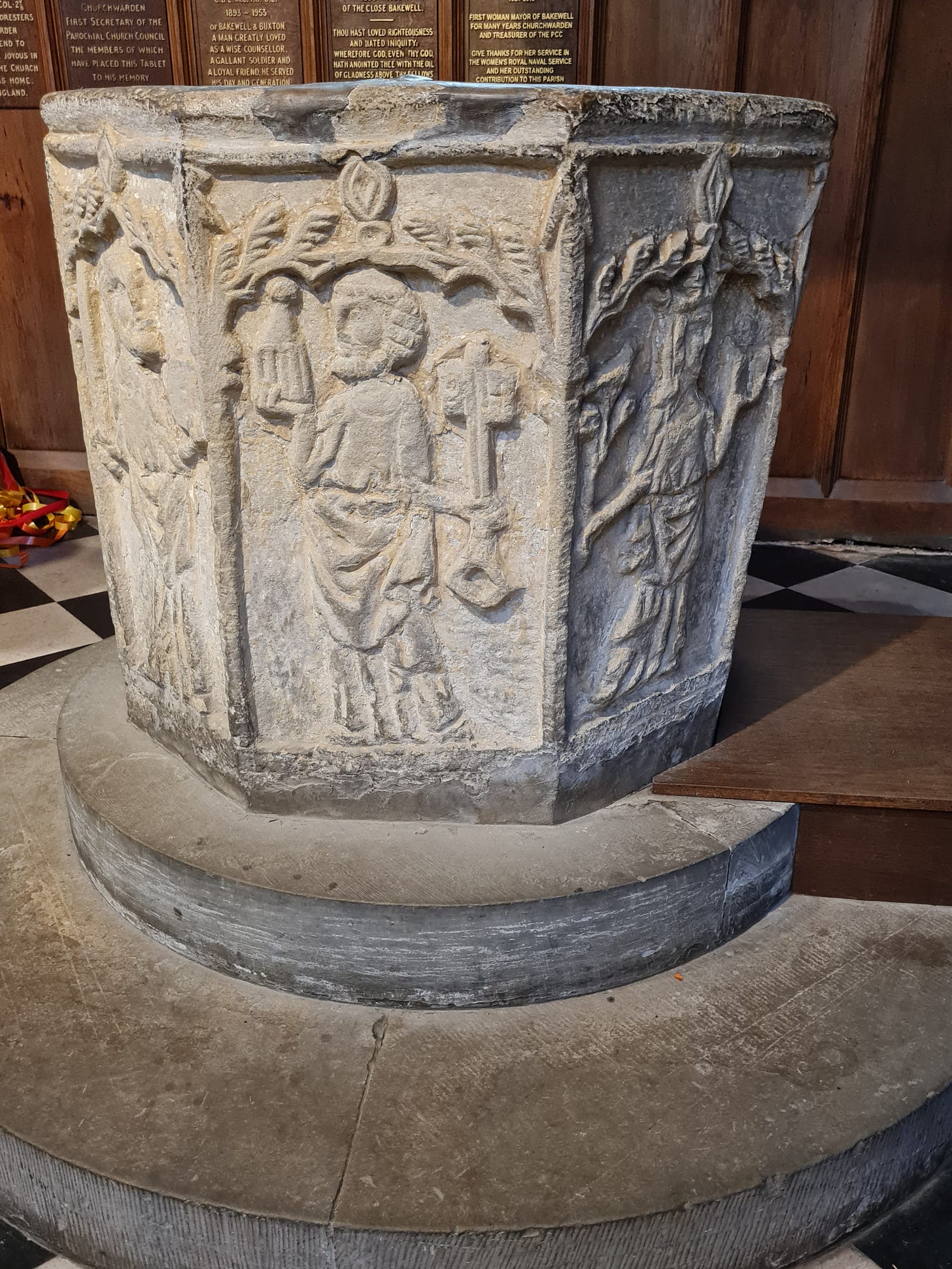
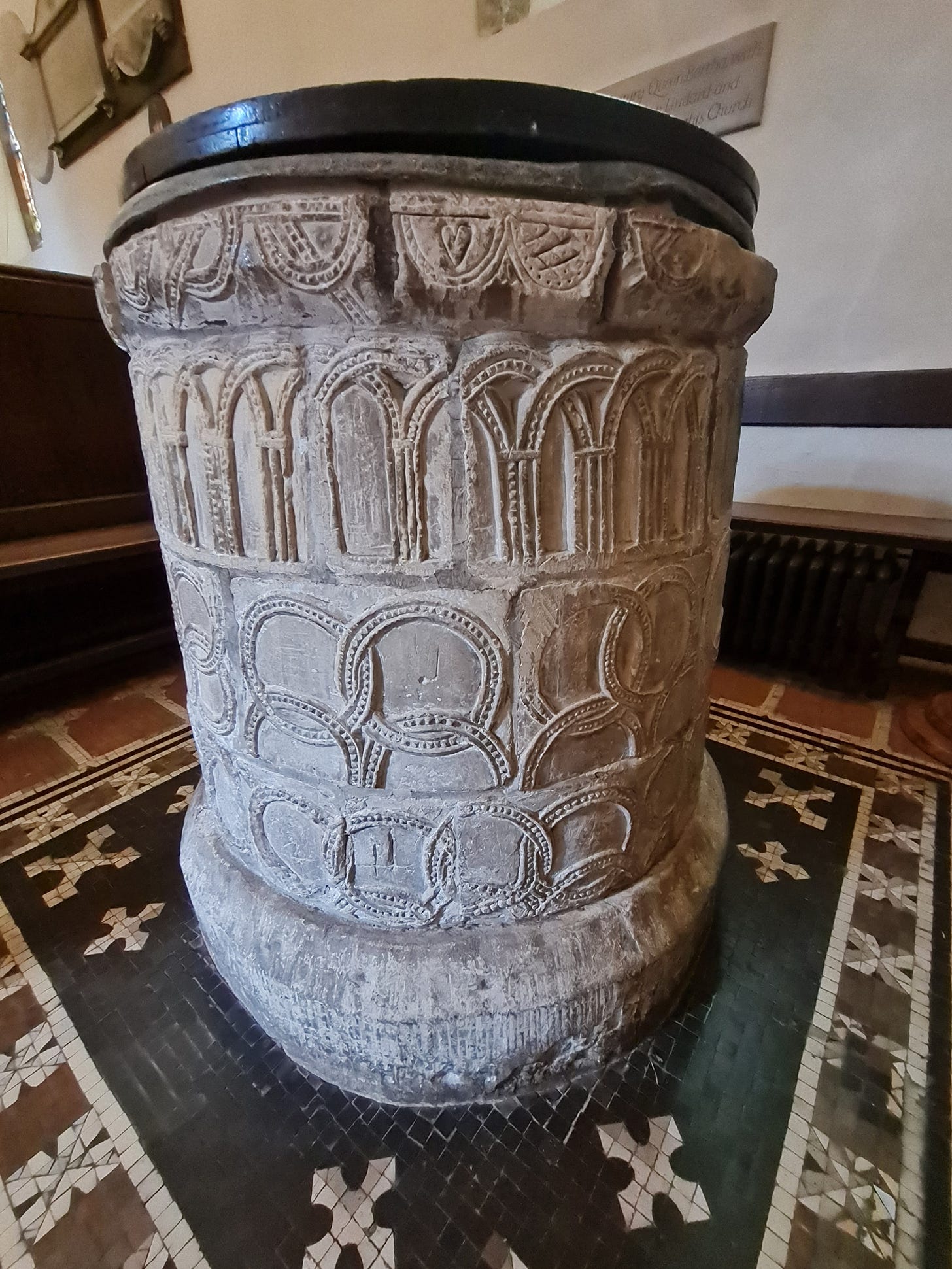

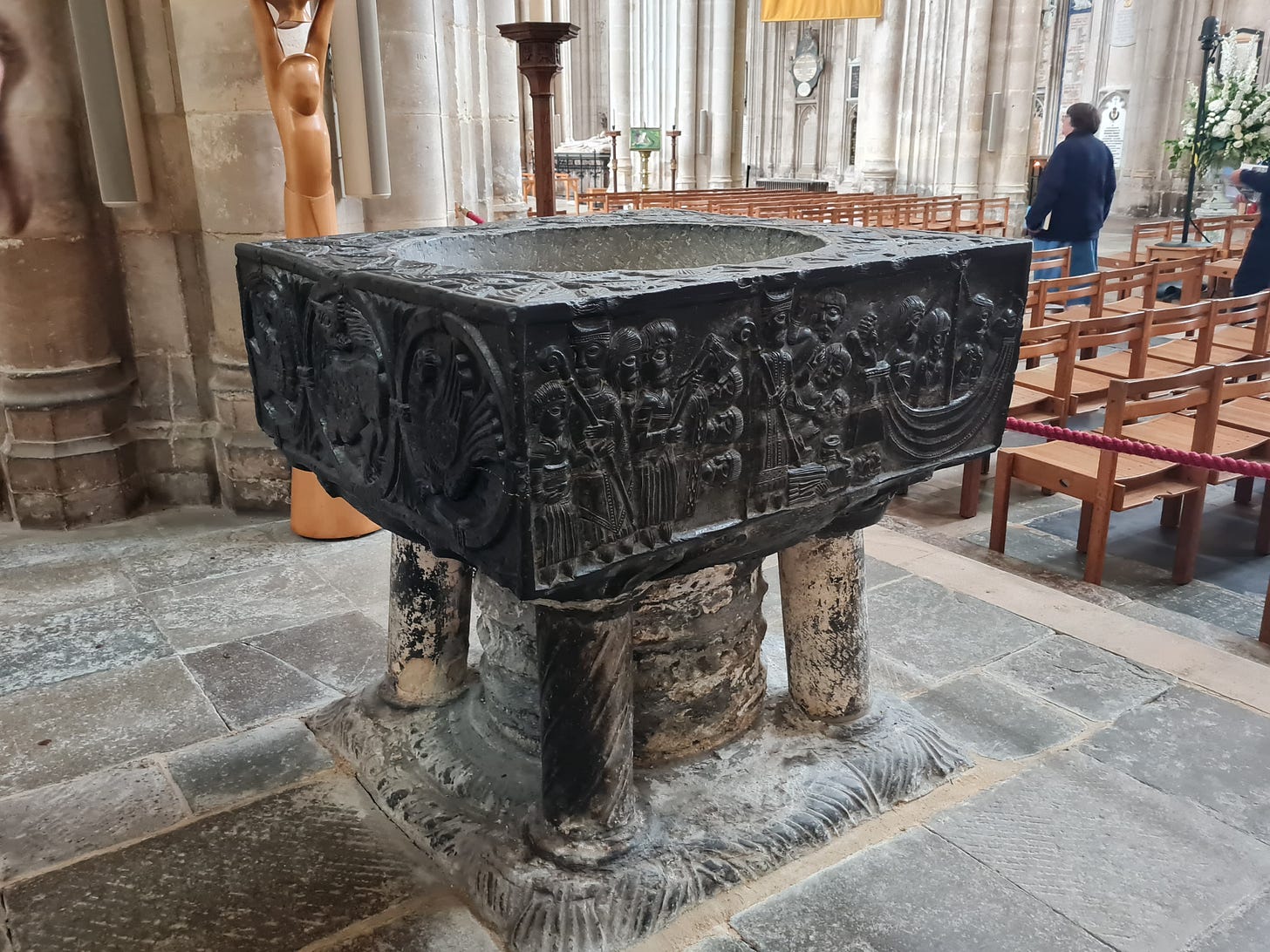
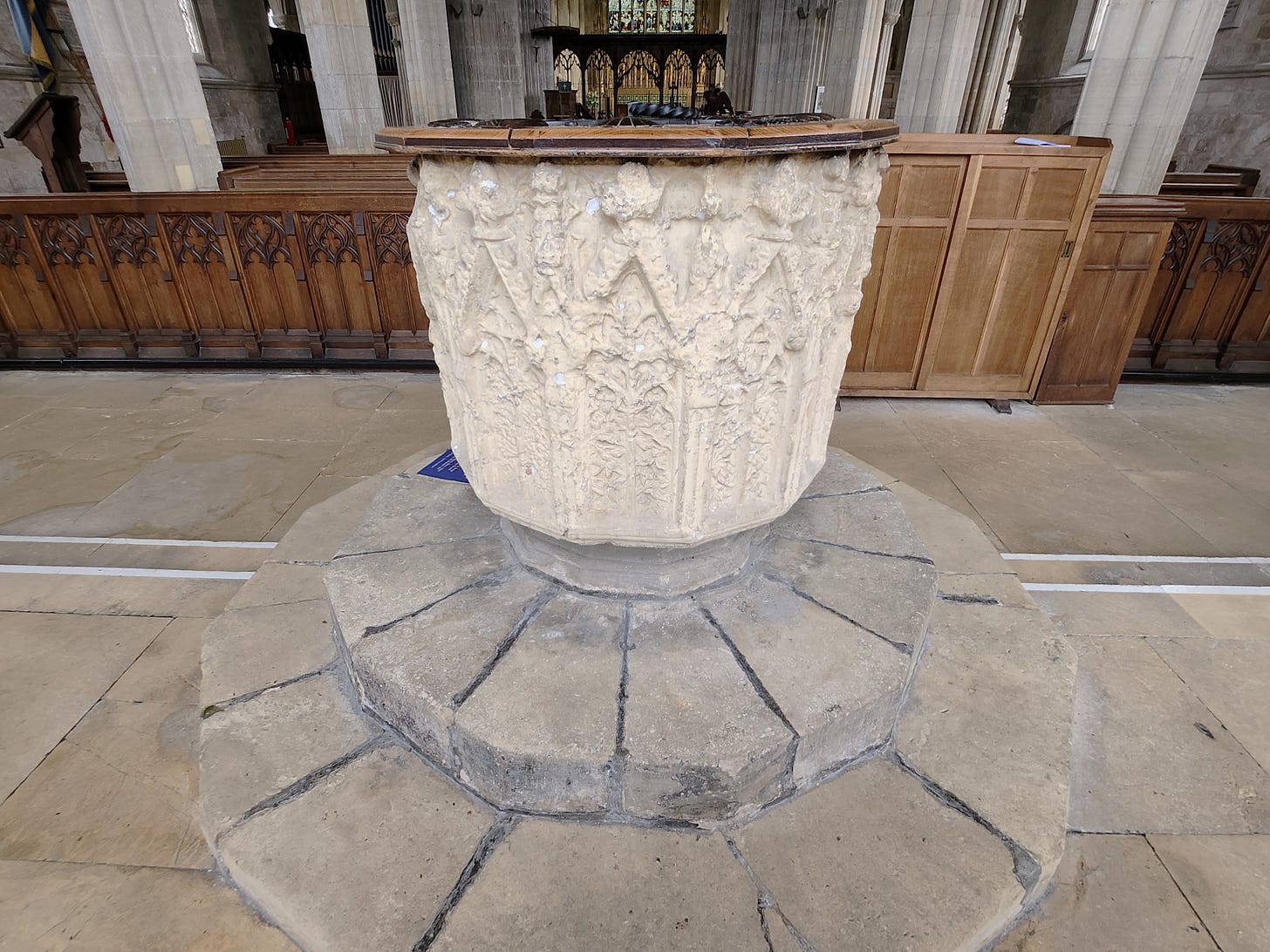
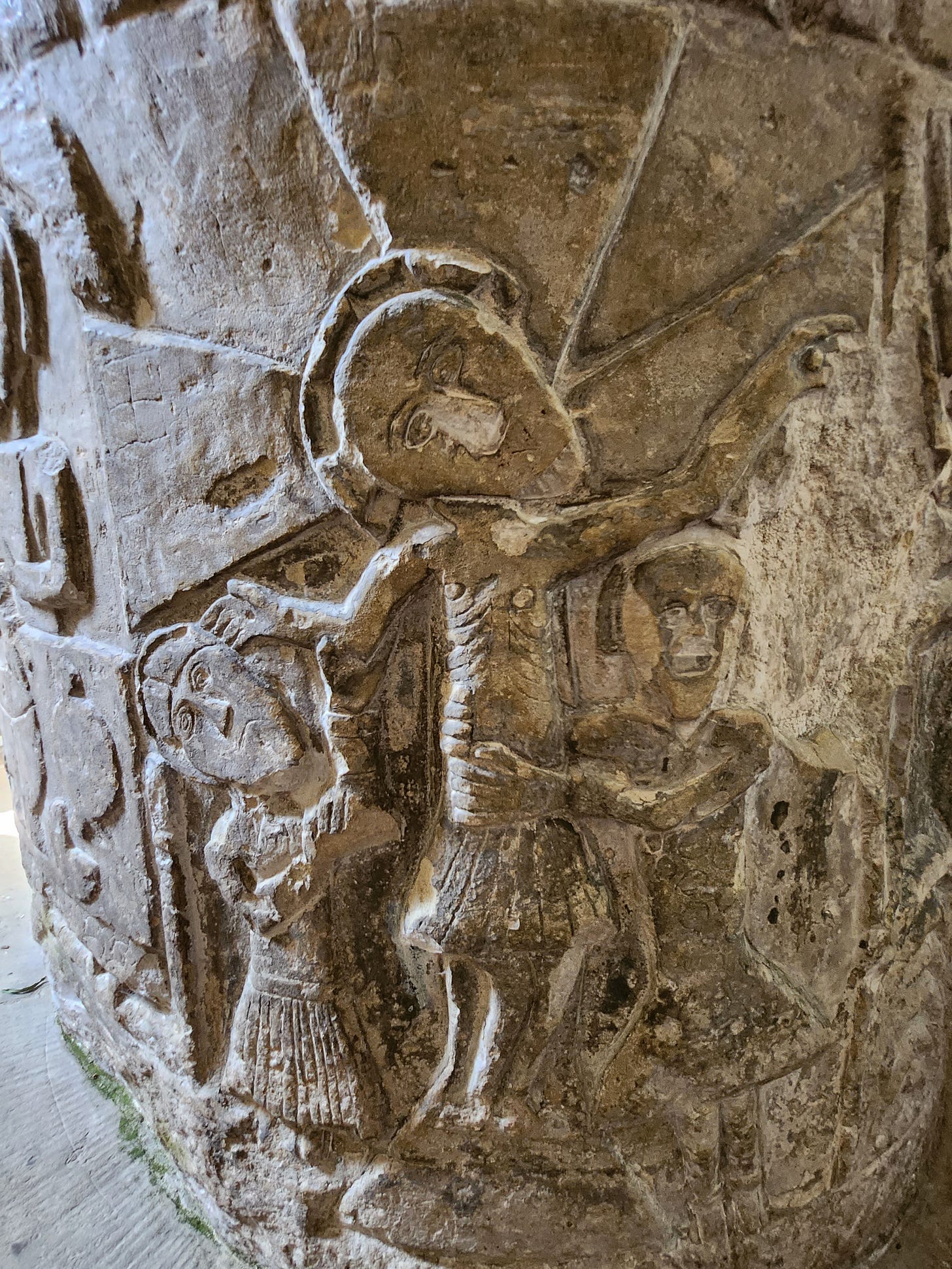


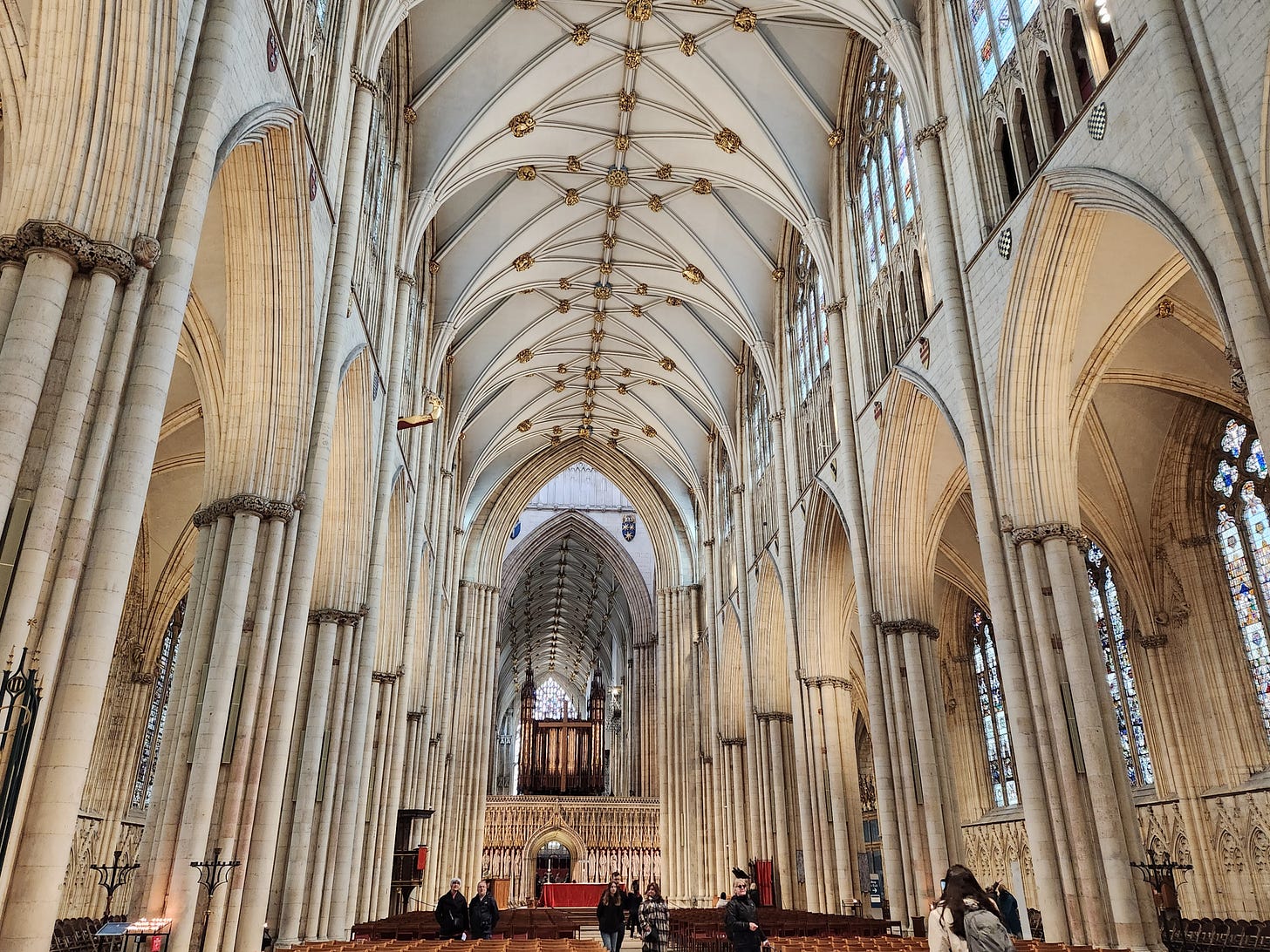





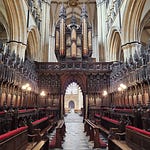
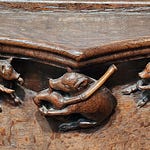



Share this post